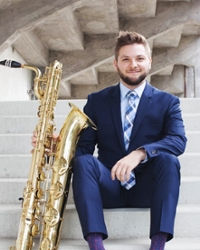
Don-Paul Kahl
PhD candidate / guest
- Name
- D. Kahl
- Telephone
- +31 71 527 2727
- d.kahl@hum.leidenuniv.nl
Don-Paul is a PhD student at the Academy of Creative and Performing Arts.
Research
Contemporary composers have recently begun to integrate techniques proper to saxophone without mouthpiece attached to the neckpiece within their works. These techniques branch into four definably separate categories: air pitch, tongue rams, trumpet sounds, and saxo-flute hybridity. ‘Air pitch’ refers to the sound when a performer blows through the saxophone neckpiece: pitch is affected by fingering and variations in embouchure and closure of the neckpiece. In ‘tongue rams’ the tongue is shoved into the neckpiece while blowing air through the horn. ‘Trumpet sounds’ refer to buzzing the lips on the neckpiece. ‘Saxo-flute hybridity’ entails the production of whistle-like pitches by blowing across the neckpiece, much like in flute playing.
The idea of separating the mouthpiece from the horn is a quite recent phenomenon. In 1980, the contemporary saxophone virtuoso, Daniel Kientzy, following in the footsteps of Jean-Marie Londeix, dared to suggest sometimes extreme and unheard of ways to produce sound to composers such as Costin Miereanu, Daniel Teruggi, and Horacio Vaggione. More recently, composers Georges Aperghis and Juan Arroyo, for example, effectively implemented the use of the saxophone without its mouthpiece. Their compositions, as well as many others, have challenged the modern day saxophonist to discover new methods of sound production. Unfortunately, performers are not yet able to understand or produce these techniques in a consistent manner resulting from insufficient existing research.
Due to a lack of available resources in comprehending and explaining the techniques of saxophone without mouthpiece, saxophonists are in the best cases coached by the composers themselves. More often than not, however, they are left to make an attempt at what is implied in the score. Unfortunately, these compositions remain largely inaccessible to the general saxophone public since they present technical problems that cannot be easily defined or solved. Problems include inconsistencies of notation, embouchure placement discrepancies, utility of air in conjunction with neckpiece and embouchure placement, sound production methods, etc. Neither guides nor methods exist which explain how to perform these techniques in a consistent and accessible manner.
This research will develop comprehension of the outcomes of playing the saxophone without its mouthpiece, as well as exploring artistic possibilities of these techniques; furthermore, it will fill a gap in the knowledge on the extended techniques of saxophone playing as it pertains to playing it without its mouthpiece. It addresses the following question:
How can saxophone without mouthpiece techniques be accurately and consistently comprehended and explained?
CV
Described by distinguished American composer John Corigliano as an "artist beyond his time," saxophonist Don-Paul Kahl has performed throughout Europe, the US, Australia, and South-East Asia. He has appeared as soloist with the Thailand Philharmonic Orchestra, the Lemmens Modern Ensemble, and the University of Florida Symphony Orchestra and Wind Symphony, among others. Don-Paul has been involved in the creation and performance of over 100 new works for saxophone. Don-Paul is a doctoral candidate for the Ph.D in Artistic Research in collaboration with Leiden University (NL) and the Orpheus Institute (BE). His previous degrees were earned from the Lemmensinstituut, the University of Florida, and Susquehanna University. His mentors are Jean-Michel Goury, Marcus Weiss, Jonathan Helton, Geoffrey Deibel, and Gail B. Levinsky, with additional study with Frederick L. Hemke. Don-Paul is a Henri Selmer Paris a nd Conn- Selmer performing artist, and performs on Selmer Paris saxophones and mouthpieces exclusively.
PhD candidate / guest
- Faculty of Humanities
- Academie der Kunsten

